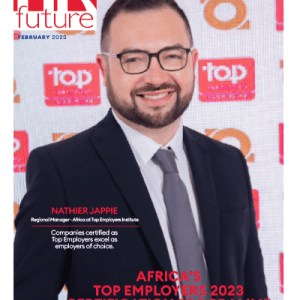Empowering HR Executives with Digital Tools for Enhanced Efficiency and Decision-Making.
This comprehensive guide explores the pivotal role of technology in human resources (HR) management, highlighting how HR executives can utilize digital tools to boost operational efficiency, foster data-driven decision-making, and improve the employee experience.
Focusing on crucial aspects such as payroll processing, talent management, and compliance, the article underscores the significance of integrating technology in HR practices.
A special emphasis is placed on the utilization of a paystub generator tool, showcasing its indispensability in streamlining payroll processes, ensuring accuracy, adhering to compliance standards, and saving time—key components of strategic HR management.
Introduction
In the ever-evolving landscape of the corporate world, the integration of technology in human resources (HR) management has transitioned from a luxury to a necessity. As businesses strive for a competitive edge, HR executives are increasingly turning to digital solutions to streamline operations, enhance strategic decision-making, and elevate the overall employee experience.
This guide delves into how technology, particularly digital tools like paystub generators, plays a crucial role in redefining HR management. By embracing these advancements, HR professionals can not only optimize their workflows but also contribute significantly to their organization’s strategic objectives.
The Evolution of HR Technology: From Paper to Digital
The journey of HR technology from its nascent stages to the sophisticated digital landscape of today offers a fascinating glimpse into how innovation can reshape an entire professional discipline. This section explores the historical evolution of HR technology, current trends shaping the industry, and the implications for HR management and strategy.
Historical Context
The evolution of HR technology began with the shift from manual, paper-based systems to automated processes. In the early days, HR tasks such as payroll processing, employee record-keeping, and recruitment were performed manually. This not only demanded significant manpower but also increased the likelihood of errors and inconsistencies.
The introduction of computers and basic HR software in the late 20th century marked the first significant step towards digitalization, automating some of the simpler tasks and laying the groundwork for the sophisticated systems we see today.
Current Trends in HR Technology
Today, the HR technology landscape is characterized by a few key trends that are shaping the future of HR management:
– Artificial Intelligence (AI) and Machine Learning: AI and machine learning are at the forefront of transforming HR processes, from enhancing candidate screening algorithms to personalizing employee learning and development programs. These technologies are enabling HR professionals to make more informed decisions based on data-driven insights.
– Cloud-Based HR Systems: The adoption of cloud-based HR systems has provided unparalleled flexibility and accessibility, allowing HR professionals and employees to access information and perform tasks from anywhere, at any time. This has been particularly crucial in supporting remote work models and global teams.
– Employee Experience Platforms: There’s a growing emphasis on the employee experience, with technology playing a key role in creating engaging and personalized employee journeys. Platforms that offer seamless onboarding, continuous learning opportunities, and wellness programs are becoming standard in forward-thinking organizations.
– Analytics and Big Data: HR analytics and big data are enabling organizations to analyze vast amounts of information, leading to better strategic decisions. Whether it’s predicting employee turnover, assessing productivity, or measuring the effectiveness of diversity and inclusion initiatives, analytics are providing HR executives with the tools they need to make evidence-based decisions.
Implications for HR Management and Strategy
The technological advancements in HR have far-reaching implications for HR management and strategy:
– Operational Efficiency: Automation of routine tasks frees up HR professionals to focus on more strategic initiatives, such as talent management and organizational development.
– Strategic Decision-Making: With access to comprehensive data and analytics, HR executives can now make decisions that are not only reactive but also proactive, anticipating changes in workforce dynamics and aligning HR strategies accordingly.
– Enhanced Employee Experience: Technology enables a more personalized and engaging experience for employees, from the recruitment process through to development and retention strategies. This not only improves employee satisfaction but also contributes to a more vibrant and productive organizational culture.
The evolution of HR technology has transformed the role of HR within organizations, positioning it as a strategic partner in achieving business objectives. As we continue to witness rapid technological advancements, the potential for HR to influence organizational success and create meaningful employee experiences is boundless.
The key for HR executives is to stay abreast of these trends, continuously evaluating and integrating new technologies to meet the evolving needs of their workforce and business.
Payroll Processing in the Digital Age
The advent of digital technology has significantly transformed the landscape of payroll processing, offering new solutions to old challenges and streamlining operations to an unprecedented level of efficiency.
This section delves into the limitations of traditional payroll systems, the transformative impact of paystub generator tools, and real-world applications that highlight the benefits of adopting such technology.
Challenges of Traditional Payroll
Traditional payroll systems, often characterized by manual data entry and paper-based record-keeping, present several challenges:
– Error-Prone Processes: Manual calculations and data entry are susceptible to human error, leading to inaccuracies in payroll, which can affect employee satisfaction and trust.
– Time-Consuming Operations: The labor-intensive nature of traditional payroll processes demands significant time and resources from HR departments, detracting from their ability to focus on strategic tasks.
– Compliance Risks: Staying compliant with tax laws and employment legislation requires constant vigilance and understanding, which can be challenging to maintain manually across different jurisdictions.
Role of Paystub Generators
Paystub generators have emerged as a cornerstone technology in modern payroll processing, addressing the aforementioned challenges effectively:
– Accuracy and Reliability: By automating calculations, paystub generators minimize the risk of errors, ensuring employees receive the correct pay and deductions are accurately calculated. This reliability enhances trust and transparency between employers and employees.
– Efficiency and Time Savings: Automating the generation of pay stubs significantly reduces the time required to complete payroll processes. HR professionals can reallocate this saved time to focus on more strategic, value-adding activities.
– Compliance and Up-to-Date Legislation: Advanced paystub generators are designed to stay current with the latest tax rates and legal requirements, automatically adjusting calculations to ensure compliance. This is particularly beneficial for businesses operating in multiple states or countries, where regulations may vary significantly.
Case Studies: The Impact of Paystub Generators
Several organizations have leveraged paystub generators to revolutionize their payroll processing, with notable outcomes:
- Small Business Transformation: A small retail chain adopted a paystub generator to manage its payroll for employees across five locations. The transition resulted in an 80% reduction in payroll processing time and significantly reduced discrepancies in pay, leading to higher employee satisfaction scores.
- Large Corporation Efficiency: A multinational corporation integrated a paystub generator with its existing HR management system, streamlining payroll operations across its global offices. The move not only ensured compliance with diverse international tax laws but also improved payroll accuracy and operational efficiency.
- Startup Scalability: A rapidly growing tech startup implemented a paystub generator to handle its expanding workforce. The tool’s scalability and ease of use allowed the startup to manage payroll processes in-house without the need for additional HR staff, even as the company grew.
These case studies underscore the tangible benefits of adopting digital tools for payroll processing. By ensuring accuracy, compliance, and efficiency, paystub generators play a pivotal role in strategic HR management. Integrating a customizable paystub template into these digital solutions further empowers businesses, allowing for seamless adaptation to diverse payroll requirements while maintaining the integrity and clarity of financial documentation.
They not only optimize payroll processes but also contribute to a broader organizational strategy by freeing up resources, enhancing employee satisfaction, and ensuring legal compliance. As such, paystub generators are not just tools for operational efficiency but strategic assets that can significantly impact an organization’s bottom line and employee experience.
Enhancing Talent Management through Technology
The landscape of talent management is undergoing a significant transformation, driven by technological advancements. This shift is enabling HR professionals to adopt more efficient, personalized, and strategic approaches to managing the workforce. This section explores the role of technology in enhancing talent acquisition, onboarding, employee development, and retention.
Talent Acquisition and Onboarding
Technology has revolutionized the way organizations attract and onboard talent:
– Automated Candidate Screening: AI-powered tools can sift through vast numbers of applications to identify the most suitable candidates based on predefined criteria, significantly reducing the time and effort involved in initial screening processes.
– Digital Onboarding Platforms: These platforms offer new hires a seamless start, enabling them to complete necessary paperwork digitally, familiarize themselves with company policies, and start training programs before their first day on the job. This not only improves the efficiency of the onboarding process but also enhances the new employee experience.
Employee Development and Retention
The digital era has also transformed employee development and retention strategies:
– Personalized Learning Experiences: Advanced Learning Management Systems (LMS) use AI to tailor training programs to individual employee needs, learning styles, and career aspirations. This personalization supports more effective learning and development, contributing to higher employee engagement and retention.
– Employee Engagement Platforms: These platforms provide continuous feedback, recognize achievements, and foster a sense of community among employees. By leveraging data analytics, companies can gain insights into employee satisfaction and engagement levels, allowing them to address concerns proactively and reduce turnover.
The Strategic Role of Technology in Talent Management
The strategic integration of technology into talent management processes offers several key advantages:
– Data-Driven Decision Making: HR professionals can utilize data analytics to make informed decisions about talent acquisition, development, and retention strategies. This can lead to better alignment between talent management practices and business objectives.
– Enhanced Candidate and Employee Experience: By streamlining recruitment and onboarding processes and offering personalized development opportunities, technology can significantly improve the overall experience for candidates and employees, making the organization more attractive to top talent.
– Increased Operational Efficiency: Automating routine tasks and processes allows HR teams to focus on strategic initiatives that contribute to the organization’s growth and success.
The use of technology in talent management not only improves operational efficiency but also plays a critical role in building a sustainable competitive advantage. By leveraging digital tools, HR professionals can attract, develop, and retain the best talent, creating a workforce that is engaged, skilled, and aligned with the organization’s goals.
As businesses continue to navigate the complexities of the modern workplace, the strategic application of technology in talent management will be a key factor in their success.
Compliance and Data Security in HR Technology
The final cornerstone of leveraging technology in strategic HR management involves navigating the complex terrain of compliance and ensuring the security of sensitive employee data.
As organizations increasingly adopt digital tools for HR processes, the importance of maintaining compliance with labor laws and safeguarding data privacy has never been more critical. This section discusses the role of technology in enhancing compliance and data security, along with its implications for HR management.
Navigating Legal Requirements
Labor laws and regulations are continually evolving, posing a significant challenge for HR departments to stay updated and ensure organizational compliance. Technology plays a pivotal role in this aspect:
– Automated Compliance Updates: Many HR software solutions are designed to automatically update in response to new labor laws and regulations. This feature ensures that HR practices remain compliant without requiring HR personnel to constantly monitor legal changes.
– Electronic Record-Keeping: Digital tools facilitate better record-keeping practices, making it easier to manage and access employee records, payroll information, and other documentation critical for compliance audits and inquiries.
Protecting Employee Data
The digitalization of HR processes involves the collection, storage, and processing of vast amounts of personal employee data, making data security a paramount concern:
– Advanced Security Measures: HR technology platforms often incorporate advanced security features, such as encryption, multi-factor authentication, and regular security audits, to protect against unauthorized access and data breaches.
– Data Privacy Compliance: Technologies that comply with data protection regulations, such as the General Data Protection Regulation (GDPR) in the European Union or the California Consumer Privacy Act (CCPA) in the United States, help organizations navigate the complexities of data privacy laws and avoid penalties.
The Implications for HR Management
The strategic integration of technology in compliance and data security has several implications for HR management:
– Risk Reduction: By ensuring compliance with labor laws and protecting employee data, technology reduces legal and financial risks associated with non-compliance and data breaches.
– Building Trust: Effective data security measures and adherence to compliance standards help build trust among employees, who feel confident that their personal information is handled responsibly and securely.
– Strategic Focus: Automating compliance and data security tasks allows HR professionals to focus on more strategic aspects of their role, such as talent management and organizational development, rather than being bogged down by administrative tasks.
In conclusion, the strategic use of technology in compliance and data security is essential for modern HR management. It not only helps organizations navigate the complexities of legal requirements and protect sensitive employee information but also supports a broader strategic focus within HR.
As technology continues to evolve, its role in facilitating compliance and ensuring data security will become increasingly central to effective HR management, underscoring the need for HR executives to stay abreast of technological advancements and integrate them into their HR practices strategically.
Conclusion: The Strategic Imperative of Technology in HR Management
The strategic integration of technology within HR management represents a paradigm shift in how organizations approach their most valuable asset: their people.
Throughout this article, we have explored the evolution of HR technology from manual processes to sophisticated digital solutions, the transformative impact of paystub generators on payroll processing, the role of technology in enhancing talent management, and the critical importance of compliance and data security in the digital age.
The cumulative effect of these advancements is a comprehensive reimagining of the HR function, from operational support to strategic partner.
Key Takeaways
– Operational Efficiency and Strategic Focus: The automation of routine tasks, particularly through tools like paystub generators, has not only enhanced operational efficiency but also allowed HR professionals to devote more time to strategic initiatives that drive organizational success.
– Data-Driven Decision-Making: The use of advanced analytics and big data in HR processes has enabled more informed decision-making, allowing organizations to better align their talent management strategies with business objectives.
– Enhanced Employee Experience: Digital tools have significantly improved the employee experience, from recruitment and onboarding to development and retention, contributing to a more engaged and productive workforce.
– Compliance and Security: Technology has become indispensable in navigating the complex landscape of legal compliance and ensuring the security of sensitive employee data, thereby reducing organizational risk.
Looking Ahead
As we look to the future, the role of technology in HR management will only grow in importance. The rapid pace of technological change, coupled with evolving workforce expectations and the increasing complexity of the global business environment, demands that HR executives remain at the forefront of innovation.
By embracing digital tools and integrating them into their strategic HR practices, organizations can not only address current challenges but also anticipate and adapt to the future dynamics of the workplace.
The strategic imperative of technology in HR management is clear: to leverage digital solutions not just for operational efficiency but as a means to unlock the full potential of the workforce. In doing so, HR professionals can contribute significantly to their organization’s competitive advantage, ensuring not just survival but success in an increasingly digital and interconnected world.
The journey towards technological integration in HR is ongoing, and the opportunities it presents are boundless. For HR executives, the time to act is now—to reimagine HR practices, to innovate, and to lead their organizations into the future with confidence and strategic vision.
Guest writer.


























